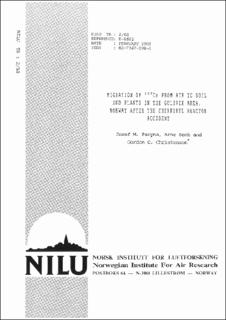Migration of 137 CS from air to soil and plants in the Gulsvik area, Norway after the Chernobyl reactor accident.
| dc.contributor.author | Pacyna, Jozef M | |
| dc.contributor.author | Semb, Arne | |
| dc.contributor.author | Christensen, Gordon C. | |
| dc.date.accessioned | 2021-06-29T10:35:02Z | |
| dc.date.available | 2021-06-29T10:35:02Z | |
| dc.date.issued | 1988 | |
| dc.identifier.isbn | 82-7247-898-6 | |
| dc.identifier.uri | https://hdl.handle.net/11250/2762211 | |
| dc.description.abstract | A migration of 137 Cs from air to soil and vegetation after the Chernobyl accident is studied using the concentrations measured in the Gulsvik area in Norway. The major part of the 137 Cs from soil to plants through their root system is not a rapid process. Only a few per cent of the deposition can be traced in plants. This seems to suggest that as far as 137 Cs is concerned, an effect of the Chernobyl releases is not an acute but a long-term phenomenon. The 137 Cs accumulation in soils is rather high but does not result in 137 Cs levels in plants and diet higher than acceptable in Norway. | |
| dc.language.iso | eng | |
| dc.publisher | NILU | |
| dc.relation.ispartof | NILU TR | |
| dc.relation.ispartofseries | NILU TR; 2/88 | |
| dc.subject | Tørravsetning | |
| dc.subject | Vegetasjon | |
| dc.subject | Radioaktivitet | |
| dc.title | Migration of 137 CS from air to soil and plants in the Gulsvik area, Norway after the Chernobyl reactor accident. | |
| dc.type | Research report | |
| dc.rights.holder | © NILU | |
| dc.source.issue | 2/88 | |
| dc.relation.project | NILU:8662 |
Files in this item
This item appears in the following Collection(s)
-
Tekniske rapporter (1970-2014) [389]
Rapporter i de avsluttede seriene Teknisk notat og Teknisk rapport (NILU TN og NILU TR).
